Ultimate Yellowstone Itinerary: How to Spend 1 to 5 Days For First-Timers
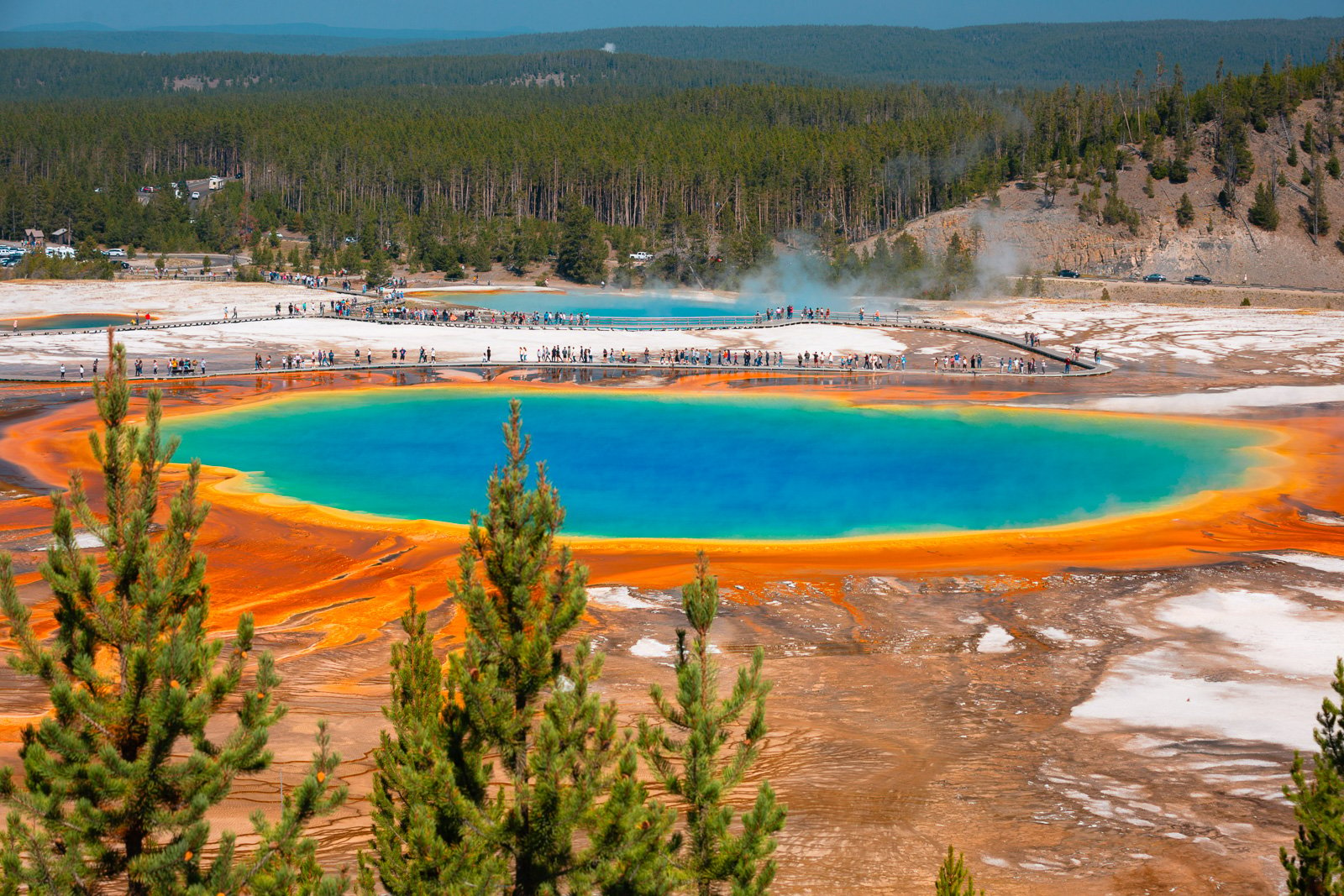
Planning your first trip to Yellowstone can feel overwhelming. With over 2 million acres, there’s just so much to see. From iconic geysers to wildlife-filled valleys, it’s tough to know where to start.
That’s why I’ve created this simple, easy-to-follow guide for first-time visitors.
I’ve put together detailed 1-day to 5-day itineraries that cover the best of Yellowstone, no matter how much time you have. These itineraries are based on my personal experience in the park and are designed to make sure you get the most out of your visit.
Let’s dive in and start planning your trip to Yellowstone!
This post may contain affiliate links, where I may receive a small commission at no additional cost to you. Read more in this disclosure policy.
How Many Days Do You Need in Yellowstone National Park?
You’ll want at least 2 to 3 days in Yellowstone to cover the main highlights. This gives you time to see the park’s biggest attractions, like Old Faithful, Grand Prismatic Spring, and the Grand Canyon of the Yellowstone, without feeling too rushed.
If you only have 1 or 2 days, focus on the southern (lower) loop, where you’ll find Old Faithful, Grand Prismatic, and Canyon Village. With 3 or more days, you can explore the northern (upper) loop, which includes Mammoth Hot Springs, Lamar Valley, and more wildlife viewing opportunities.
The itineraries below are designed to help you perfect your time in the park, whether you have just a single day or up to five days.
1 to 5 Day Yellowstone Itinerary Breakdowns
Navigating Yellowstone can be tricky because of its massive size and the figure-eight layout of the Grand Loop Road. This scenic drive connects the park’s main attractions, but it’s important to plan your days around nearby sights to avoid long drives between stops.
I’ve grouped these itineraries by location to help you make the most of your time. Whether you have 1 day or 5, you can use the table below to jump to the itinerary that fits your trip.
| Trip Length | Key Attractions | Where to Stay |
|---|---|---|
| 1 Day | Old Faithful, Upper Geyser Basin, Grand Prismatic Spring, Grand Canyon of Yellowstone, Hayden Valley | Canyon Village or West Yellowstone |
| 2 Days | All 1-Day attractions + Midway Geyser Basin, Firehole Canyon, Norris Geyser Basin, Yellowstone Lake, Mud Volcano, West Thumb Geyser Basin | Canyon Village or West Yellowstone |
| 3 Days | All 2-Day attractions + Mammoth Hot Springs, Tower-Roosevelt, Lamar Valley | Canyon Village or split between West Yellowstone and Gardiner |
| 4 Days | All 3-Day attractions + Lower Geyser Basin, Mount Washburn Trail | Canyon Village or split between West Yellowstone and Gardiner |
| 5 Days | All 4-Day attractions + Beartooth Highway or Beaver Ponds Trail | Canyon Village or split between West Yellowstone and Gardiner |
One Day Yellowstone Itinerary
If you only have one day in Yellowstone, stick to the most iconic spots to make the most of your time. This itinerary covers Old Faithful, Grand Prismatic Spring, the Grand Canyon of the Yellowstone, and Hayden Valley for wildlife viewing.
Morning: Old Faithful and Upper Geyser Basin
Start your day early at Old Faithful to beat the crowds. Old Faithful erupts every 1.5 hours, so check the geyser prediction schedule the night before to time your arrival. After watching the eruption, explore the rest of the Upper Geyser Basin. Don’t miss Riverside Geyser, Chromatic Pool, and Morning Glory Pool. Wrap up your time here with a quick stop at the Old Faithful Inn and the visitor center.


Arrive at Old Faithful early, as the area gets crowded by mid-morning. If you have more than an hour before the next Old Faithful eruption, walk the Upper Geyser Basin first, then return to Old Faithful in time to catch the eruption.
Early Afternoon: Grand Prismatic Spring Overlook
Next, drive a few minutes to the Fairy Falls Trailhead for the best view of Grand Prismatic Spring from above. It’s a short and easy 1.5-mile hike, and trust me, it’s worth it! If hiking isn’t your thing, you can still see the colorful spring from the accessible boardwalk at Midway Geyser Basin.

Late Afternoon: Grand Canyon of the Yellowstone
After your morning among the geothermal features, head to the Grand Canyon of the Yellowstone. Start on the South Rim with Artist Point for stunning views of Lower Falls. If you have time, explore the North Rim and stop at Lookout Point for another perspective on the canyon.


Evening: Hayden Valley
End your day with a relaxing drive through Hayden Valley to spot wildlife. Bison are a guarantee here, but if you’re lucky, you might also see elk, moose, or even a grizzly. Bring binoculars to get the best views of wildlife in the distance.

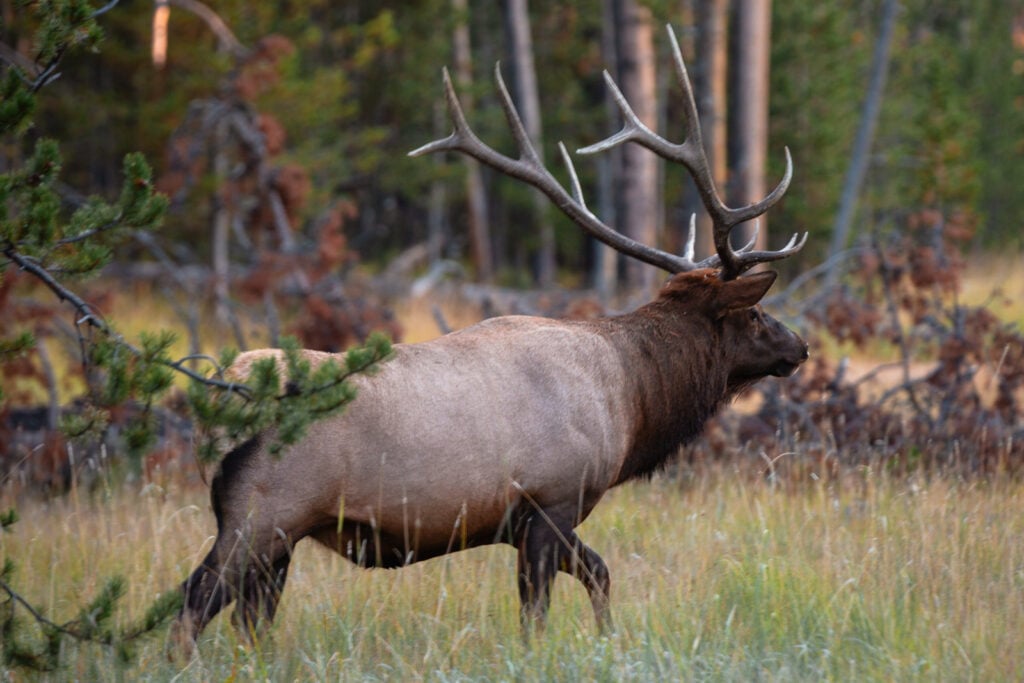
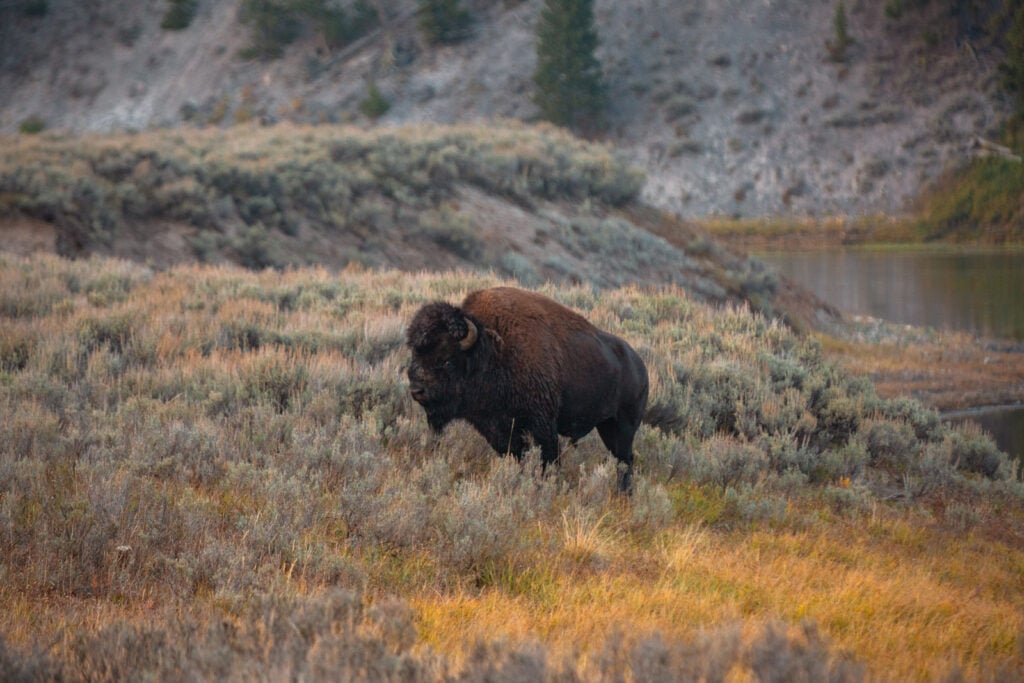
Where to Stay: Canyon Village or West Yellowstone
The most convenient place to stay is in Canyon Village, at either Canyon Lodge or Canyon Campground, which is close to both the Grand Canyon and Hayden Valley. If you’re staying outside the park, West Yellowstone is the closest option, about an hour away.
2-Day or 3-Day Yellowstone Itinerary
If you have two days in Yellowstone, you can explore the same destinations as the 1-day itinerary but at a more relaxed pace. It’s a great way to avoid feeling rushed. With three days, you’ll have time to see the highlights of the northern loop too, including Mammoth Hot Springs and Lamar Valley.
Day 1: Old Faithful, Upper Geyser Basin, & Grand Prismatic Spring
Morning: Old Faithful & Upper Geyser Basin
Start early at Old Faithful. It erupts every 1.5 hours, so check the eruption schedule the night before to time your arrival. After watching the eruption, spend a couple of hours exploring the Upper Geyser Basin. Highlights include Riverside Geyser, Chromatic Pool, and Morning Glory Pool. Stop by the Old Faithful Inn and the visitor center before moving on.



Early Afternoon: Grand Prismatic Spring Overlook & Midway Geyser Basin
Drive to the Fairy Falls Trailhead for the best view of Grand Prismatic Spring from above, stopping at Biscuit Basin along the way. The easy 1.5-mile Fairy Falls hike to the overlook has a bit of elevation gain, but the aerial views of the spring are worth it! After seeing Grand Prismatic from above, you can get an up-close look by walking the Midway Geyser Basin boardwalk. This route is more accessible and better for those unable to hike to the overlook.

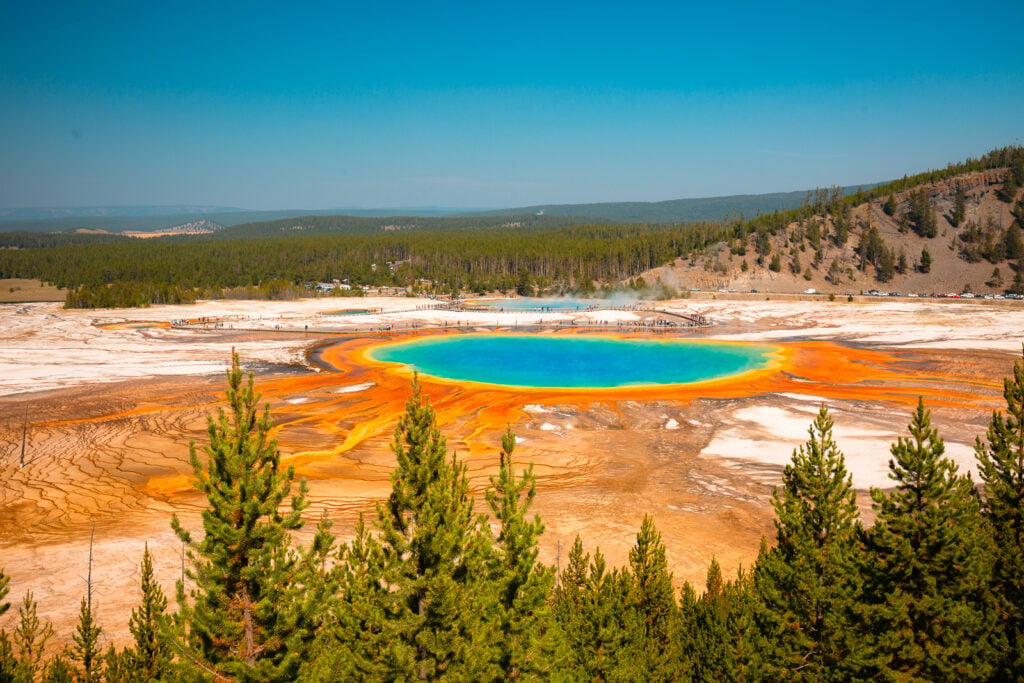

Late Afternoon: Firehole Canyon & Norris Geyser Basin
Take a scenic drive on 7.5-mile Firehole Canyon Road, which features a 40-foot roadside waterfall and swimming area, one of only a few in the park. Then, explore Norris Geyser Basin, home to two scenic boardwalk loops— the Porcelain Basin and Back Basin.
Norris Geyser Basin is very busy from 10 AM to 4 PM. I recommend aiming to arrive at Norris Geyser Basin just after 4 PM to have an easier time finding parking and to avoid crowds on the boardwalks.



Where to Stay: Canyon Village or West Yellowstone
Canyon Lodge or Canyon Campground are the best options inside the park. If you’re staying outside the park, West Yellowstone is about 45 minutes away.
Day 2: Grand Canyon of the Yellowstone & Yellowstone Lake
Early Morning: Hayden Valley
Start your day with a scenic drive through Hayden Valley to spot wildlife. Bison are common, and you may even see elk or grizzly bears. Morning is one of my favorite times to drive through Hayden Valley as the stark contrast in temperature from the cool air and hydrothermal features creates mystical steam.

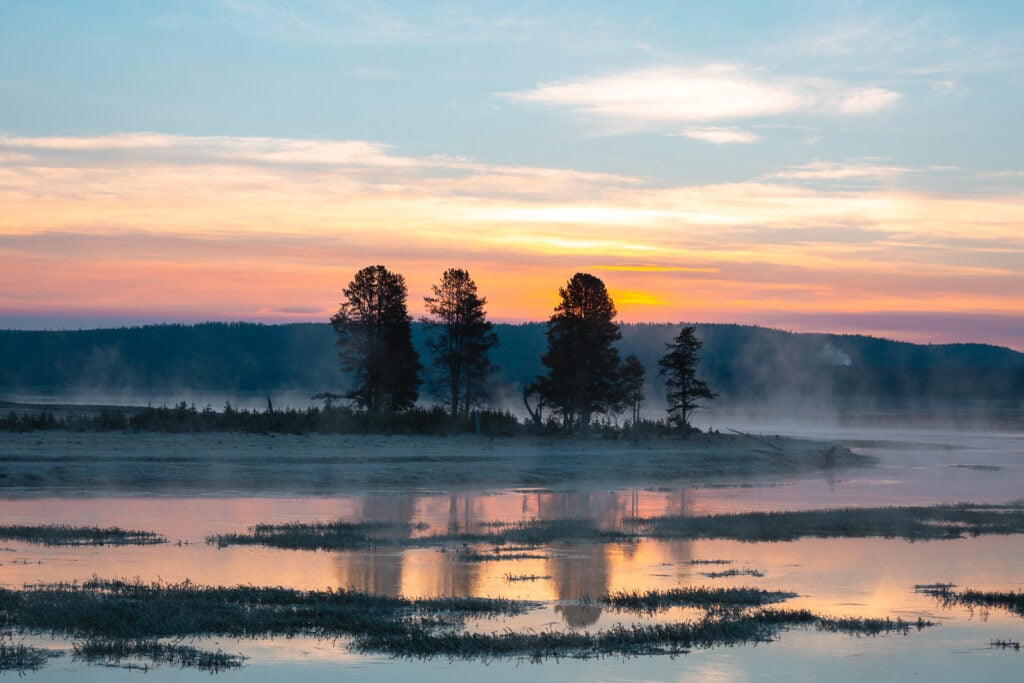

Mid Morning: Grand Canyon of the Yellowstone
Explore the South Rim first, stopping at Artist Point for views of Lower Falls. Then, head to the North Rim to check out Lookout Point, Grand View, and Inspiration Point. If you’re up for a short, but steep hike, I recommend Brink of the Lower Falls or Red Rock Point.



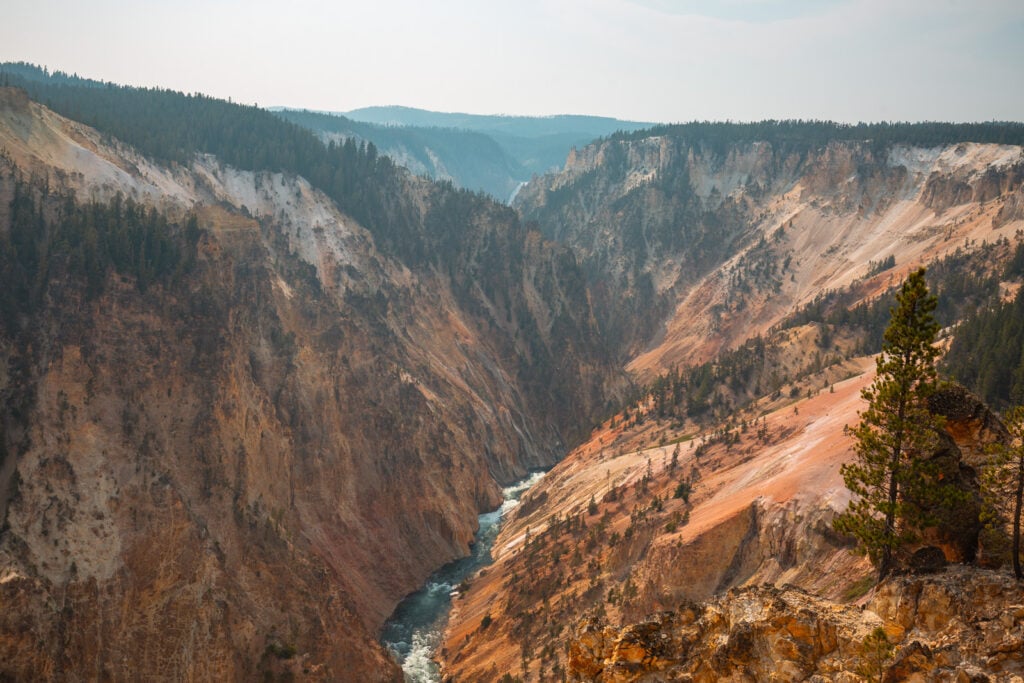
Early Afternoon: Mud Volcano & Yellowstone Lake
Continue south through Hayden Valley to Mud Volcano, a geothermal area known for its bubbling mud pots. Then, head to Yellowstone Lake, where you can take a short hike along the 2.5-mile Storm Point Trail for beautiful views along the lakeshore.


Late Afternoon: West Thumb Geyser Basin
If you have some time, visit the historic Lake Yellowstone Hotel. Then, stop by West Thumb Geyser Basin, located on the shore of Yellowstone Lake. Don’t miss Abyss Pool and Black Pool, two of the basin’s most colorful features.

Where to Stay: Canyon Village or West Yellowstone
I recommend staying at the same place as your first night for simplicity – either Canyon Village or West Yellowstone. However, if you’re heading south to Grand Teton the next morning, Grant Village is a good option as well.
Day 3: Mammoth Hot Springs & Lamar Valley
Morning: Mammoth Hot Springs
Explore the terraced limestone formations at Mammoth Hot Springs. Walk through the Lower Terrace and drive through the Upper Terrace Loop for the best views. Afterward, stop by the nearby Albright Visitor Center and walk through historic Fort Yellowstone.
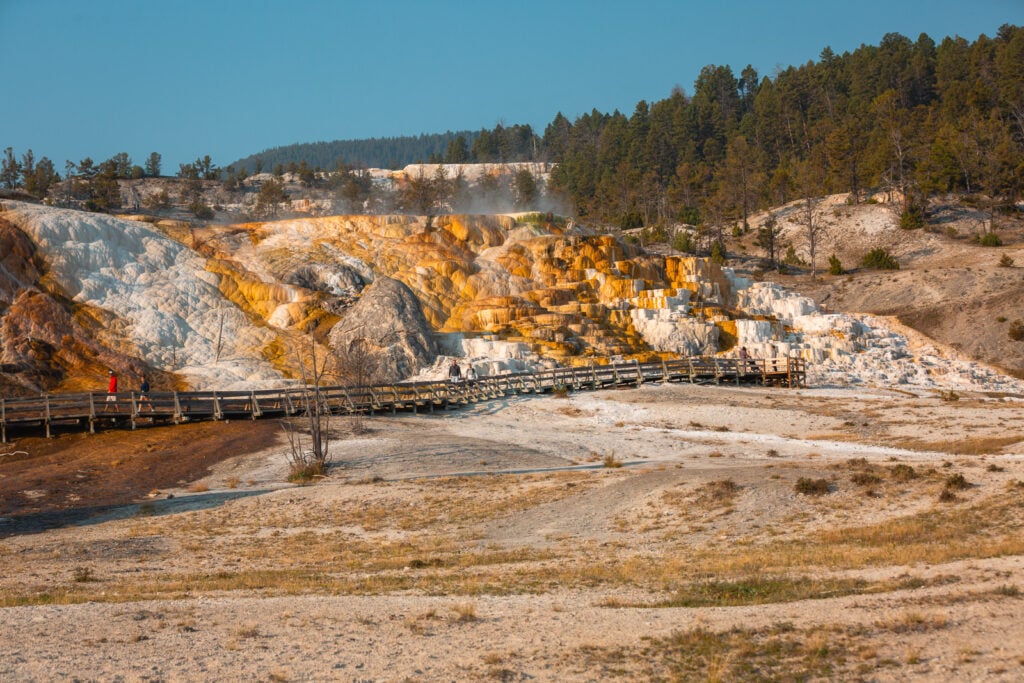


Afternoon: Tower-Roosevelt & Tower Fall
Head east on Grand Loop Road to Tower-Roosevelt. Check out the scenic Tower Fall viewpoint and, if you’re up for it, hike the short but challenging switchbacks past the viewpoint to an overlook of the Yellowstone River.

Late Afternoon: Lamar Valley
End your trip with a wildlife-spotting drive through Lamar Valley. It’s a prime location to see bison, wolves, coyotes, and other animals. Bring binoculars for a better view, especially around sunset when the wildlife is more active.

Where to Stay: Canyon Village or Gardiner
If you’ve been staying in Canyon Village, it’s a good option for your final night. Otherwise, consider staying in Gardiner instead of West Yellowstone as it’s a much closer drive from Lamar Valley.
4-Day or 5-Day Yellowstone Itinerary
In my opinion, four days in Yellowstone National Park is the perfect amount of time to see all the top attractions and the best things to do. If you have five days, you can add a scenic drive or a few extra hikes.
To avoid repetitiveness, I’ve outlined the itinerary below instead of repeating all the details. You can read the descriptions of repeated activities in the 1-3 day itineraries above! New additions are called out below.
Day 1: Old Faithful, Upper Geyser Basin, & Grand Prismatic Spring
- Morning: Old Faithful & Upper Geyser Basin
- Early Afternoon: Black Sand Basin or Biscuit Basin
- Mid Afternoon: Grand Prismatic Spring Overlook & Midway Geyser Basin
- Late Afternoon: Fountain Paint Pots & Firehole Canyon Drive
- Where to Stay: Canyon Village or West Yellowstone
New for the 4-Day Itinerary: Fountain Paint Pots. Located in the Lower Geyser Basin, this less crowded geothermal area is a quick 0.6-mile loop, allowing you to get off-the-beaten-path.

Day 2: Grand Canyon of the Yellowstone & Yellowstone Lake
- Early Morning: Hayden Valley for wildlife viewing
- Mid Morning: Grand Canyon of the Yellowstone (Artist Point, Lookout Point, Brink of the Lower Falls)
- Early Afternoon: Mud Volcano & Storm Point Trail
- Late Afternoon: West Thumb Geyser Basin
- Where to Stay: Canyon Village or West Yellowstone

Day 3: Tower-Roosevelt & Lamar Valley
- Morning: Hike Mount Washburn Trail via Dunraven Pass (6.8 miles, challenging)
- Early Afternoon: Tower Fall & Calcite Springs Overlook
- Late Afternoon: Wildlife watching in Lamar Valley
- Where to Stay: Canyon Village or Gardiner
New for the 4-Day Itinerary: Mount Washburn Trail. This incredible panoramic trail is routinely rated as one of the top hikes in Yellowstone. The 6.8-mile hike starts at Dunraven Pass and takes you to the summit of Mount Washburn, standing at 10,200 feet.

Pack a lunch as dining options are limited in Tower-Roosevelt. Spend your time in Lamar Valley picnicking while you look for wildlife. And don’t forget binoculars!
Day 4: Norris Geyser Basin & Mammoth Hot Springs
- Morning: Norris Geyser Basin (Porcelain Basin & Back Basin loops)
- Early Afternoon: Mammoth Hot Springs (Lower & Upper Terrace)
- Late Afternoon: Visit Roosevelt Arch & Boiling River Hot Springs
- Where to Stay: Mammoth Hot Springs or Gardiner
New for the 4-Day Itinerary: Roosevelt Arch & Boiling River Hot Springs. Roosevelt Arch was built to honor Teddy Roosevelt, one of the pioneers of the national park system. In the early days of the park, Gardiner was the primary way to enter the park, with most visitors passing through Roosevelt Arch to enter. End your time in Yellowstone with a swim in the Boiling River Hot Springs swimming area just outside of Gardiner.
Note: Boiling River is currently closed due to 2022 flooding. Grab dinner in Gardiner instead to end your day in Yellowstone.


Day 5: Beartooth Highway or Beaver Ponds Trail
If you have five days in the park, pick one of these options:
- Drive Beartooth Highway. This scenic drive outside Yellowstone’s Northeast Entrance is often called one of the most beautiful in the U.S. (Note: Only open from late May to mid-October.)
- Hike Beaver Ponds Loop Trail. Spend the morning hiking the 5-mile, wildlife-packed Beaver Ponds Loop Trail in the Mammoth Hot Springs area. In the afternoon, head back out to Lamar Valley to look for more wildlife.


Where to Stay: Mammoth Hot Springs or Gardiner
For your last night, I recommend spending the night in Mammoth Hot Springs or Gardiner, particularly if you’re heading north to Glacier National Park or flying out of Bozeman the next day.
If You Have More Time in Yellowstone
If you have more than five days to spend in Yellowstone, I highly recommend checking out more of the best things to do! Here are some ideas:
- Hike the Fairy Falls Trail
- Drive Firehole Lake Drive and see Great Fountain Geyser erupt
- Conquer the challenging Avalanche Peak Trail near Yellowstone Lake
- Drive the scenic Blacktail Plateau Drive near Mammoth
- Go on the Old West Dinner Cookout
- Hike the North Rim Trail or South Rim Trail at the Grand Canyon of the Yellowstone
- Hike or bike the Lone Star Geyser Trail
- Walk the Artist Paint Pots Trail
Planning to visit more than just Yellowstone? Check out my guide for combining Yellowstone with Grand Teton for an epic multi-park road trip.


Where to Stay In and Near Yellowstone
If possible, I highly recommend staying inside the park to minimize driving time, but you’ll need to book about a year in advance. If you’re planning your trip less than six months out, you’ll likely need to stay outside the park in nearby towns like West Yellowstone or Gardiner.
In the itineraries above, I mention where to stay based on the region you’ll explore each day. Here’s a quick overview of the best options:
Inside the Park:
- Canyon Village: Canyon Lodge & Cabins or Canyon Campground
- Mammoth Hot Springs: Mammoth Hot Springs Hotel & Cabins or Mammoth Campground
Outside the Park:
- West Yellowstone: Kelly Inn or Stage Coach Inn
- Gardiner: Roosevelt Hotel or Yellowstone Gateway Inn
Need more detailed recommendations for lodging inside and outside the park? I’ve got you covered with my comprehensive guide on the best places to stay during your Yellowstone trip.
Logistics and Planning for Your Yellowstone Itinerary
Here are my top quick tips to help you plan your Yellowstone trip and make the most of your time in the park:
- Start Early to Avoid Crowds: Yellowstone gets crowded, especially in the summer. The best way to avoid the crowds and lines at the entrance station is to start your day by 7 AM.
- Download Offline Maps: Cell service in Yellowstone is very limited. Be sure to download offline maps on your phone and save all of your reservation info before entering the park. I like to use Google Maps offline, but a printed map from the visitor center is always a good backup.
- Book Lodging and Campsites Early: Accommodations inside the park book up quickly, often a year in advance. If you can’t find lodging inside the park, check for options in nearby towns like West Yellowstone or Gardiner instead.
- Parking Tips: Parking lots at popular attractions fill up by mid-morning. If you arrive later, plan to circle the lot or park farther away and walk. At spots like the Grand Canyon of the Yellowstone or Norris Geyser Basin, it’s best to visit early or late in the day.
- Pack a Picnic: Food options inside Yellowstone are crowded and overpriced. I recommend packing a picnic lunch and snacks so you can eat on the go between activities. There are plenty of scenic pullouts and picnic areas throughout the park where you can stop for a break.
- Carry Bear Spray: If you plan on hiking in Yellowstone, always carry bear spray. It’s available for rent or purchase in local stores near the park. Make sure it’s always easily accessible (not inside your backpack) while hiking. Stay 25 yards away from bison, female elk, deer, and moose. You should stay 100 yards away from more aggressive animals like bears, wolves, and bull elk during rutting season.
- Acclimate to the Elevation: The Yellowstone Caldera is located above 9,000 feet. For most visitors, it will take a few days to acclimate to the elevation. I recommend saving your more strenuous activities for later on in your trip and spending the first few days doing scenic drives or easy hikes through the geyser basins.
Planning to visit more than one national park this year? Save money and skip the lines with the America the Beautiful Pass, which gives you unlimited access to over 400 national park sites for the next 12 months. If you’re over 62, you can get the Senior Lifetime Pass instead for even more savings!
Frequently Asked Questions About Your Yellowstone Itinerary
Final Thoughts on Planning Your Yellowstone Itinerary
With this guide, you now have a clear plan for making the most of your time in Yellowstone, whether you’re spending one day or five. From iconic geysers to scenic drives and wildlife hotspots, there’s no shortage of incredible sights to see.
Don’t forget to check road conditions, make your reservations early, and pack for all types of weather. With the right planning, your Yellowstone trip will be one to remember!
More Yellowstone Guides to Help Plan Your Trip:
Don’t Forget to Save This Post on Pinterest




